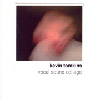 Since establishing their own small-run label to release their work, the duo behind Sutcliffe Jugend and Bodychoke have become extremely prolific, releasing multiple projects this year alone. While to some this could seem excessive and overindulgent, each release from Kevin Tomkins and Paul Taylor (as well as joint releases) have taken entirely different directions. These two releases are both vastly different: Loss is mostly just vocals and guitar (recorded over the span of two days), while Vocal Sound Collage is exactly what the title indicates.
Since establishing their own small-run label to release their work, the duo behind Sutcliffe Jugend and Bodychoke have become extremely prolific, releasing multiple projects this year alone. While to some this could seem excessive and overindulgent, each release from Kevin Tomkins and Paul Taylor (as well as joint releases) have taken entirely different directions. These two releases are both vastly different: Loss is mostly just vocals and guitar (recorded over the span of two days), while Vocal Sound Collage is exactly what the title indicates.
Loss opens with "Dignity for a Dying Man," a 15-minute piece of noisy chaos over gliding violin loops and low register murky guitar. The combination of the noisier guitar and scatter-shot sound collage with Tomkins’ snarling, disgusted vocals give the track a rambling, manic feel, though the looped violin keeps it somewhat reigned in. The violin also appears on "I Cannot Loose the Thing I Never Had" and also provides a more gentle counter-balance to the rawer noise collage elements, but its calmer opening, paired with gentle guitar, starkly contrasts the industrial collage that ends the song.
The backward loops and wheezing sounds of "See Her Disappear" make it perhaps the most dissonant piece here. Never really reaching into the land of noise, it instead cradles a creepy sense of isolation, from the random looped sounds and nasal vocals that appear feel like the sonic equivalent of a madman’s ranting. "Fucking Loss" and "Double Dare" go the other direction, being equally traditional guitar playing and fuzzed out chaos, the latter’s soft vocals and random violent guitar outbursts give a good sense of the alternating depression and rage that comes with any form of loss.
Kevin Tomkins’ vocals, especially in the late 1990s incarnation of Sutcliffe Jugend, have always worked best while in a rage: the SJ material managed to be disturbing and sound truly deranged even when the lyrics occasionally delved into near self-parody territory, and his screaming in Bodychoke complimented his more quiet passages well. Here it is a bit more of a mixed bag, considering most of the pieces are built upon dramatic, disgusted snarling, which is sometimes TOO over the top. Occasionally he channels a bit of Nick Cave with his angst, but never quite reaching the same levels of technicality, instead moments feel more like the angry ramblings of a shut-in. Which, given the concept and motivation behind the album, works well in that capacity.
samples:

The other album is split down the middle into two distinct parts. The first four pieces date from 2003 and 2004 of collaged vocal noises. The first of the four layers cut up fragments of voice that sound like they’re speaking an alien language over drawn out and pitch shifted ambient passages of voice. The second segment mixes frog-like guttural groans and falsetto like gibberish singing, not far removed from some of Mike Patton’s work or Yamatsuka Eye’s vocal spasms with Naked City. There is a more musical quality here, with occasional bits of jazzy scat singing and lighter moments that resemble an army of gnomes running around a field.
The third segment’s deep grows and breathing are pegged out volume wise to the point of overdriven distortion and the rhythmic elements and processing makes it feel like a capella power electronics, only eventually lightened at the end by layered chanting and more vast open soundscapes. The tracks that follow, "Attic Songs," all were recorded in one day in November 2008, take on a different quality that feel less like sound collage, and more like traditional music with voice as all instruments.
"Gentle Teather" takes buzzing loops of voice fragments and places actual soft vocals on top, the actual words counterbalancing the random phonemes and syllables nicely. "Shock and Tease" musically takes a rhythm made simply from repeating the track title over and over, but has a lighter, open quality to it. "River Fog" makes Tomkins’ voice sound like electronic percussion and droning synths that are rhythmically sequenced, with vocals on top giving it a much more "song" like quality that the first half of the disc doesn’t show.
The closing "The Third State" is the only track that incorporates other elements: Tomkins adds clarinet while his long time musical partner Paul Taylor works a vocoder and the result is a piece of marching like rhythms and clarinet squeaks that give a lighter, almost jaunty feel while the others had a more pronounced element of darkness to them.
While the Between Silences label has been releasing a lot of material from these two, it doesn’t feel excessive or overly indulgent. Each work has been distinct and extremely different from one release to the next so any attempt to combine albums would easily result in a great deal of disparate and unrelated sounds alongside each other. While I would assume many people are frustrated that these aren’t all manic, angry rants against women and prostitutes over hellish feedback, I find this greater openness and experimentation far more engaging and multifaceted than just the harsh noise they do so well.
samples:
Read More

